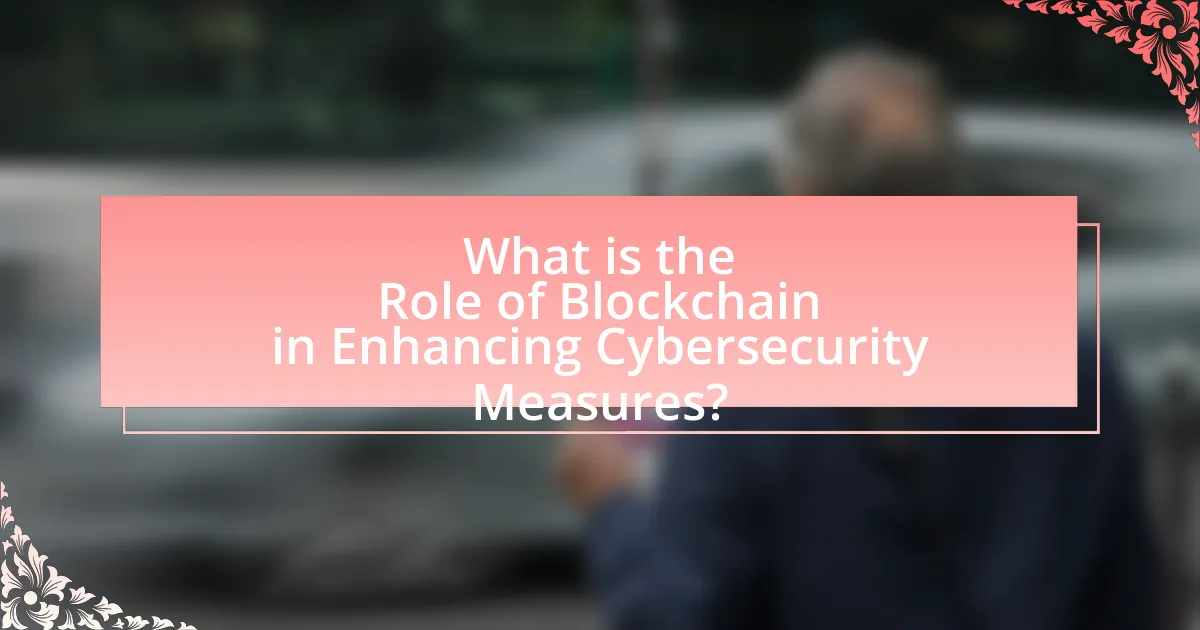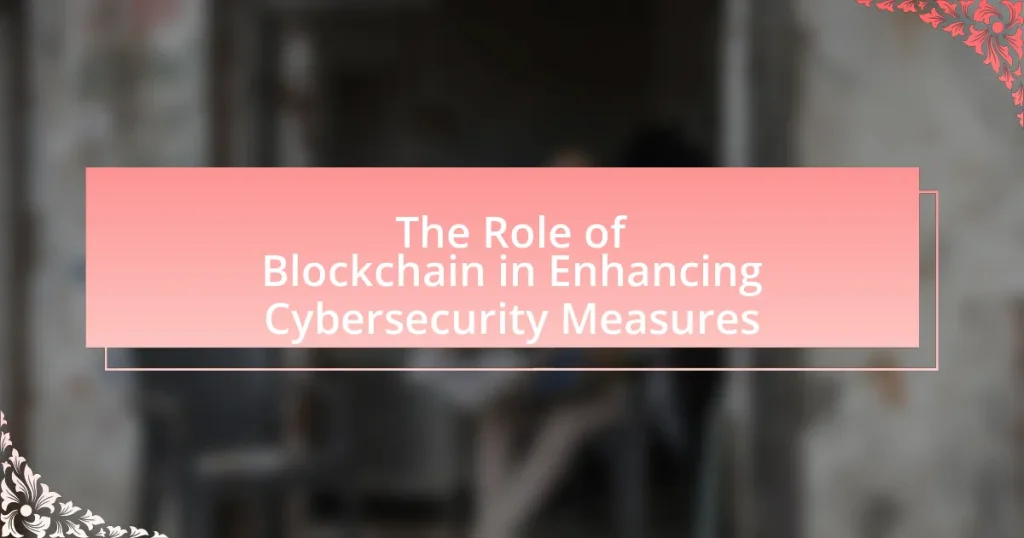The article focuses on the role of blockchain technology in enhancing cybersecurity measures. It outlines how blockchain’s decentralized and immutable ledger secures data against unauthorized access and tampering, significantly reducing the risk of data breaches. Key features such as decentralization, immutability, and cryptographic security are discussed, along with the challenges blockchain faces in the cybersecurity landscape, including scalability and regulatory compliance. The article also explores practical applications of blockchain in various industries, its integration with artificial intelligence, and best practices for organizations looking to implement blockchain solutions for improved cybersecurity.

What is the Role of Blockchain in Enhancing Cybersecurity Measures?
Blockchain enhances cybersecurity measures by providing a decentralized and immutable ledger that secures data against unauthorized access and tampering. This technology ensures that once data is recorded, it cannot be altered without consensus from the network, significantly reducing the risk of data breaches. For instance, a study by the University of Cambridge found that blockchain can improve data integrity and transparency, making it harder for cybercriminals to manipulate information. Additionally, the use of cryptographic techniques in blockchain protects sensitive data during transmission, further strengthening cybersecurity protocols.
How does blockchain technology contribute to cybersecurity?
Blockchain technology enhances cybersecurity by providing a decentralized and immutable ledger that secures data against unauthorized access and tampering. This decentralized nature means that data is not stored in a single location, reducing the risk of centralized attacks. Additionally, the immutability of blockchain ensures that once data is recorded, it cannot be altered or deleted without consensus from the network, which protects against data breaches and fraud. For instance, a study by the World Economic Forum in 2020 highlighted that blockchain can significantly reduce the risk of cyberattacks by ensuring data integrity and transparency in transactions.
What are the fundamental principles of blockchain that enhance security?
The fundamental principles of blockchain that enhance security include decentralization, immutability, and cryptographic hashing. Decentralization reduces the risk of a single point of failure, as data is distributed across multiple nodes, making it difficult for attackers to compromise the entire network. Immutability ensures that once data is recorded on the blockchain, it cannot be altered or deleted, which protects against fraud and unauthorized changes. Cryptographic hashing secures data by converting it into a fixed-size string of characters, making it nearly impossible to reverse-engineer or tamper with the original information. These principles collectively create a robust security framework that is resistant to attacks and enhances the integrity of data within the blockchain.
How does decentralization in blockchain improve data integrity?
Decentralization in blockchain enhances data integrity by distributing data across multiple nodes, which reduces the risk of data tampering. Each node maintains a copy of the entire blockchain, and any changes to the data require consensus from the majority of nodes, making unauthorized alterations nearly impossible. This consensus mechanism, often achieved through protocols like Proof of Work or Proof of Stake, ensures that all transactions are verified and recorded accurately. For instance, Bitcoin’s blockchain has demonstrated resilience against attacks due to its decentralized nature, as altering any single block would require overwhelming computational power to change the majority of nodes simultaneously.
What are the key features of blockchain that bolster cybersecurity?
The key features of blockchain that bolster cybersecurity include decentralization, immutability, transparency, and cryptographic security. Decentralization reduces the risk of a single point of failure, as data is distributed across multiple nodes, making it difficult for attackers to compromise the entire network. Immutability ensures that once data is recorded on the blockchain, it cannot be altered or deleted, which protects against data tampering and fraud. Transparency allows all participants to view transactions, enhancing accountability and trust among users. Cryptographic security employs advanced encryption techniques to protect data integrity and confidentiality, making unauthorized access extremely challenging. These features collectively create a robust framework that significantly enhances cybersecurity measures.
How does encryption in blockchain protect sensitive information?
Encryption in blockchain protects sensitive information by ensuring that data is transformed into a secure format that is unreadable without the appropriate decryption key. This process utilizes cryptographic algorithms, such as SHA-256, which are designed to create a unique hash for each block of data, making it nearly impossible for unauthorized users to alter or access the information without detection. Furthermore, the decentralized nature of blockchain means that data is stored across multiple nodes, enhancing security by eliminating a single point of failure. This combination of cryptographic techniques and distributed storage effectively safeguards sensitive information from unauthorized access and tampering.
What role do smart contracts play in enhancing cybersecurity measures?
Smart contracts enhance cybersecurity measures by automating and enforcing agreements without the need for intermediaries, thereby reducing the risk of human error and fraud. They operate on blockchain technology, which provides a decentralized and immutable ledger, ensuring that once a contract is executed, it cannot be altered or tampered with. This immutability is crucial for maintaining data integrity and trust in digital transactions. Additionally, smart contracts can incorporate security protocols that automatically trigger actions in response to specific conditions, such as alerting stakeholders of potential breaches or executing predefined responses to unauthorized access attempts. The use of cryptographic techniques within smart contracts further protects sensitive information, making it difficult for malicious actors to exploit vulnerabilities.
What challenges does blockchain face in the cybersecurity landscape?
Blockchain faces several challenges in the cybersecurity landscape, including scalability, regulatory compliance, and vulnerability to attacks. Scalability issues arise as blockchain networks struggle to handle a high volume of transactions efficiently, which can lead to slower processing times and increased costs. Regulatory compliance is another challenge, as varying laws across jurisdictions can complicate the implementation of blockchain solutions in cybersecurity. Additionally, while blockchain is often touted for its security features, it is still susceptible to specific attacks, such as 51% attacks, where a single entity gains control over the majority of the network’s mining power, potentially compromising the integrity of the blockchain. These challenges highlight the complexities of integrating blockchain technology into existing cybersecurity frameworks.
How do scalability issues affect blockchain’s effectiveness in cybersecurity?
Scalability issues significantly hinder blockchain’s effectiveness in cybersecurity by limiting transaction throughput and increasing latency. When a blockchain network cannot efficiently handle a growing number of transactions, it leads to slower processing times, which can delay critical security operations such as real-time threat detection and response. For instance, Bitcoin’s network can process only about seven transactions per second, which is inadequate for large-scale applications requiring rapid data verification. This bottleneck can make blockchain less viable for cybersecurity applications that demand high-speed data processing and immediate action against threats. Consequently, the inability to scale effectively can undermine the reliability and responsiveness of blockchain-based cybersecurity solutions.
What are the potential vulnerabilities associated with blockchain technology?
Blockchain technology has potential vulnerabilities that include 51% attacks, smart contract flaws, and inadequate privacy measures. A 51% attack occurs when a single entity gains control of more than half of the network’s mining power, allowing it to manipulate transactions and double-spend coins. Smart contracts, which are self-executing contracts with the terms directly written into code, can contain bugs or vulnerabilities that hackers can exploit, leading to financial losses. Additionally, while blockchain is often praised for its transparency, this can also compromise user privacy, as transaction details are publicly accessible. These vulnerabilities highlight the need for ongoing security assessments and improvements in blockchain systems.
How can organizations implement blockchain for better cybersecurity?
Organizations can implement blockchain for better cybersecurity by utilizing its decentralized and immutable nature to enhance data integrity and security. By deploying blockchain technology, organizations can create tamper-proof records of transactions and data exchanges, which significantly reduces the risk of data breaches and unauthorized access. For instance, a study by the World Economic Forum indicates that blockchain can reduce the cost of cybersecurity incidents by up to 30% due to its ability to provide transparent and verifiable data trails. Additionally, organizations can use smart contracts on blockchain platforms to automate security protocols, ensuring that only authorized users can access sensitive information, thereby further strengthening their cybersecurity posture.
What steps should organizations take to integrate blockchain into their cybersecurity strategy?
Organizations should take the following steps to integrate blockchain into their cybersecurity strategy: first, assess their current cybersecurity framework to identify vulnerabilities that blockchain technology can address. This assessment allows organizations to understand how blockchain’s decentralized nature can enhance data integrity and security. Next, they should pilot blockchain solutions in specific areas, such as identity management or secure data sharing, to evaluate effectiveness and scalability.
Following successful pilots, organizations should develop a comprehensive implementation plan that includes training for staff on blockchain technology and its applications in cybersecurity. Additionally, they must ensure compliance with relevant regulations and standards, as blockchain can introduce new legal considerations. Finally, organizations should continuously monitor and update their blockchain solutions to adapt to evolving cybersecurity threats, leveraging blockchain’s inherent transparency and immutability to improve incident response and threat detection.
These steps are supported by the increasing adoption of blockchain in various sectors, demonstrating its potential to enhance cybersecurity measures effectively.
What best practices should be followed when using blockchain for cybersecurity?
To enhance cybersecurity using blockchain, organizations should implement best practices such as ensuring data integrity through cryptographic hashing, utilizing decentralized storage to reduce single points of failure, and employing smart contracts for automated security protocols. These practices are essential because cryptographic hashing secures data against tampering, decentralized storage mitigates risks associated with centralized data breaches, and smart contracts automate compliance and security checks, thereby reducing human error. For instance, a study by the World Economic Forum highlights that blockchain can reduce data breaches by up to 80% when integrated with existing cybersecurity frameworks.

What are the real-world applications of blockchain in cybersecurity?
Blockchain technology has several real-world applications in cybersecurity, primarily enhancing data integrity, identity management, and secure transactions. For instance, blockchain can provide immutable records of data changes, making it difficult for unauthorized users to alter information without detection. This application is crucial in sectors like finance and healthcare, where data integrity is paramount. Additionally, blockchain facilitates decentralized identity management, allowing users to control their personal information and reduce the risk of identity theft. Companies like Evernym are implementing blockchain for self-sovereign identity solutions, which empower individuals to manage their credentials securely. Furthermore, blockchain enhances secure transactions through smart contracts, which automatically execute agreements when predefined conditions are met, minimizing the risk of fraud. These applications demonstrate how blockchain can significantly bolster cybersecurity measures across various industries.
How is blockchain being used in various industries to enhance security?
Blockchain is being used in various industries to enhance security by providing a decentralized and immutable ledger that ensures data integrity and transparency. In the financial sector, for instance, blockchain technology secures transactions by eliminating intermediaries, reducing fraud, and enabling real-time auditing. According to a report by the World Economic Forum, blockchain can reduce fraud in financial transactions by up to 80%. In healthcare, blockchain enhances security by protecting patient data through encryption and access controls, ensuring that only authorized personnel can access sensitive information. A study published in the Journal of Medical Internet Research highlights that blockchain can improve data sharing while maintaining patient privacy. In supply chain management, blockchain enhances security by providing traceability of products, which helps in verifying authenticity and preventing counterfeiting. Research from the IBM Institute for Business Value indicates that 72% of supply chain executives believe blockchain will enhance security and transparency in their operations. Overall, blockchain’s unique characteristics make it a powerful tool for enhancing security across multiple industries.
What examples exist of blockchain improving cybersecurity in finance?
Blockchain enhances cybersecurity in finance through several key examples. One prominent example is the use of blockchain for secure transactions, as seen in platforms like Ripple, which enables real-time cross-border payments while ensuring data integrity and reducing fraud risks. Additionally, the implementation of smart contracts on Ethereum allows for automated and secure execution of financial agreements, minimizing the potential for human error and unauthorized access. Furthermore, the decentralized nature of blockchain technology helps protect sensitive financial data from cyberattacks, as demonstrated by projects like Chainalysis, which uses blockchain analytics to detect and prevent fraudulent activities in cryptocurrency transactions. These examples illustrate how blockchain technology significantly improves cybersecurity measures in the financial sector.
How is blockchain utilized in healthcare to protect patient data?
Blockchain is utilized in healthcare to protect patient data by providing a decentralized and immutable ledger that ensures data integrity and security. This technology enables secure sharing of patient information among authorized parties while maintaining patient privacy through encryption and access controls. For instance, a study published in the Journal of Medical Internet Research highlights that blockchain can prevent unauthorized access and data tampering, thereby enhancing trust in electronic health records. Additionally, the use of smart contracts within blockchain systems automates compliance with data protection regulations, further safeguarding patient information.
What are the emerging trends in blockchain and cybersecurity?
Emerging trends in blockchain and cybersecurity include the integration of decentralized identity solutions, enhanced data privacy through zero-knowledge proofs, and the use of smart contracts for automated security protocols. Decentralized identity solutions allow users to control their personal information, reducing the risk of data breaches. Zero-knowledge proofs enable verification of data without revealing the data itself, thus enhancing privacy. Additionally, smart contracts automate security measures, ensuring compliance and reducing human error. These trends are supported by increasing adoption in sectors like finance and healthcare, where data security is paramount.
How is artificial intelligence being integrated with blockchain for enhanced security?
Artificial intelligence is being integrated with blockchain to enhance security by utilizing AI algorithms to analyze and detect anomalies in blockchain transactions. This integration allows for real-time monitoring and identification of fraudulent activities, as AI can process vast amounts of data quickly and accurately. For instance, AI can enhance the security of smart contracts by predicting potential vulnerabilities and automating the auditing process, thereby reducing the risk of exploitation. Additionally, the decentralized nature of blockchain ensures that AI models operate on secure, tamper-proof data, further strengthening the overall security framework. This synergy between AI and blockchain is supported by various studies, including research from the IEEE, which highlights the effectiveness of AI in improving the integrity and security of blockchain systems.
What future developments can we expect in blockchain technology related to cybersecurity?
Future developments in blockchain technology related to cybersecurity will likely include enhanced decentralized identity management systems and improved data integrity protocols. These advancements aim to mitigate risks associated with identity theft and data breaches, as decentralized identity solutions allow users to control their personal information without relying on centralized databases, which are often vulnerable to attacks. Additionally, blockchain’s immutable ledger can provide verifiable audit trails for data transactions, ensuring that any alterations are easily traceable. According to a report by the World Economic Forum, the integration of blockchain in cybersecurity can reduce the costs of data breaches by up to 30% by providing more secure and transparent systems.

What are the implications of blockchain on future cybersecurity measures?
Blockchain technology significantly enhances future cybersecurity measures by providing decentralized data storage, which reduces the risk of single points of failure. This decentralization ensures that data is distributed across multiple nodes, making it more resilient to attacks such as hacking or data tampering. For instance, a study by the World Economic Forum highlights that blockchain can improve data integrity and security through its immutable ledger feature, which records transactions in a way that cannot be altered retroactively. Additionally, the use of cryptographic techniques in blockchain enhances authentication processes, making unauthorized access more difficult. These implications suggest that as organizations adopt blockchain, they can expect improved security protocols and reduced vulnerabilities in their cybersecurity frameworks.
How might blockchain reshape the cybersecurity landscape in the coming years?
Blockchain technology is poised to significantly reshape the cybersecurity landscape by enhancing data integrity, improving authentication processes, and enabling decentralized security measures. The immutable nature of blockchain ensures that once data is recorded, it cannot be altered without consensus from the network, thereby reducing the risk of data tampering and cyber attacks. For instance, a study by the World Economic Forum highlights that blockchain can provide a secure framework for identity management, which is crucial in preventing identity theft and fraud. Additionally, the decentralized architecture of blockchain eliminates single points of failure, making it more resilient against attacks compared to traditional centralized systems. This shift towards decentralized security frameworks is expected to lead to more robust cybersecurity protocols in various sectors, including finance, healthcare, and supply chain management.
What role will regulatory frameworks play in the adoption of blockchain for cybersecurity?
Regulatory frameworks will play a crucial role in the adoption of blockchain for cybersecurity by establishing standards and guidelines that ensure compliance, security, and interoperability. These frameworks can facilitate trust among stakeholders, as they provide a legal basis for the use of blockchain technologies in securing sensitive data and transactions. For instance, regulations like the General Data Protection Regulation (GDPR) in Europe set requirements for data protection that can influence how blockchain solutions are designed and implemented, ensuring they meet privacy and security standards. Furthermore, regulatory clarity can encourage investment and innovation in blockchain technologies, as businesses are more likely to adopt solutions that align with established legal requirements.
How can organizations prepare for the future of cybersecurity with blockchain?
Organizations can prepare for the future of cybersecurity with blockchain by integrating decentralized ledger technology to enhance data integrity and security. Blockchain’s immutable nature ensures that once data is recorded, it cannot be altered, which significantly reduces the risk of data breaches and fraud. For instance, a study by the World Economic Forum highlights that blockchain can provide a secure framework for identity management, thereby preventing unauthorized access to sensitive information. Additionally, organizations can implement smart contracts to automate and enforce security protocols, further minimizing human error and potential vulnerabilities. By adopting these blockchain solutions, organizations can create a more resilient cybersecurity posture against evolving threats.
What practical tips can organizations follow to leverage blockchain for cybersecurity?
Organizations can leverage blockchain for cybersecurity by implementing decentralized identity management, which enhances user authentication and reduces the risk of data breaches. By utilizing blockchain’s immutable ledger, organizations can securely store and verify user identities, ensuring that only authorized individuals access sensitive information. Additionally, employing smart contracts can automate security protocols, minimizing human error and streamlining incident response processes. Research indicates that blockchain can reduce fraud by up to 50% in various sectors, demonstrating its effectiveness in enhancing cybersecurity measures.
What common pitfalls should organizations avoid when implementing blockchain solutions?
Organizations should avoid several common pitfalls when implementing blockchain solutions, including inadequate understanding of the technology, lack of clear objectives, and insufficient stakeholder engagement. A thorough comprehension of blockchain’s capabilities and limitations is essential, as many organizations overestimate its benefits without recognizing the complexities involved. Additionally, setting vague or unrealistic goals can lead to project failures; for instance, a study by Deloitte found that 74% of organizations cited unclear objectives as a significant barrier to successful blockchain implementation. Furthermore, engaging all relevant stakeholders is crucial, as failure to do so can result in misalignment and resistance to change, which can derail the project.
How can organizations assess the effectiveness of their blockchain-based cybersecurity measures?
Organizations can assess the effectiveness of their blockchain-based cybersecurity measures by conducting regular audits and performance evaluations of the blockchain systems in place. These assessments should include analyzing transaction integrity, monitoring for unauthorized access, and evaluating the speed and accuracy of data retrieval. For instance, a study by the International Journal of Information Management highlights that organizations can utilize metrics such as the number of successful attacks thwarted and the time taken to detect anomalies to gauge the effectiveness of their blockchain security. Additionally, organizations can implement penetration testing and vulnerability assessments specifically tailored to blockchain technology to identify weaknesses and improve their security posture.


